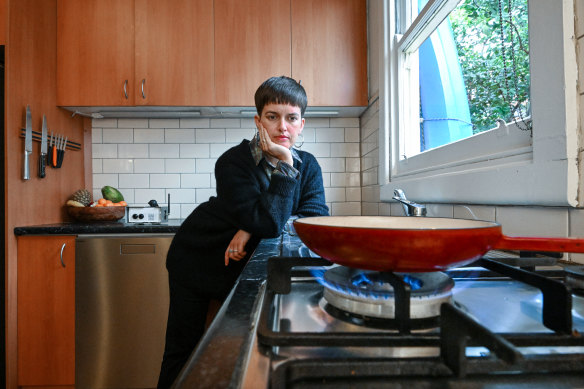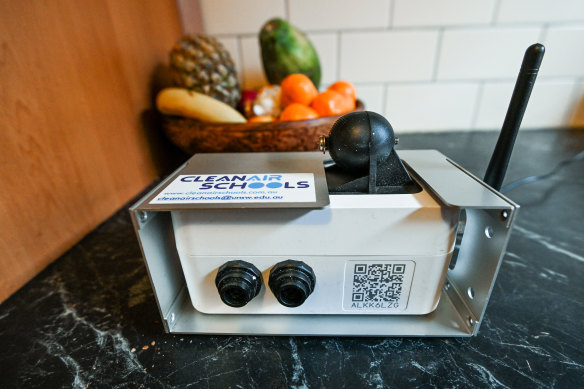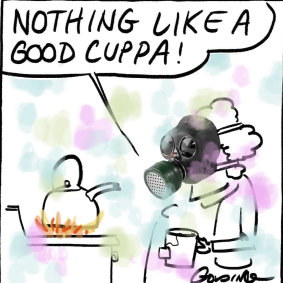This was published 2 years ago
I measured gas pollution in my kitchen and this is what I found (yikes)
By Miki Perkins
Was it the vegetarian sausages? I’d left them cooking and they were lightly singed (we ate them anyway). Maybe it was the geriatric extractor fan; I’d been meaning to replace it.
The gas hob might have needed maintenance, I guess. Or that time we’d (profligately) used smoke-producing olive oil, rather than vegetable. Did that count? It was impossible to narrow it down.

Environment reporter Miki Perkins in her kitchen with a three-year-old gas cooktop. Perkins monitored the air quality for a week and was surprised by the results.Credit: Joe Armao
But after using a borrowed pollution monitor in our kitchen for a week to check the quality of our indoor air while using our gas cooktop, I was a little surprised to find the results were concerning.
Half a dozen times, the monitor showed the amount of tiny PM2.5 particles in our kitchen soared to the same levels as the toxic air people were breathing in Sydney during the Black Summer bushfires. Yikes.
Globally, the climate damage caused by “natural” gas – a fossil fuel and greenhouse gas – is well understood. Producing and burning gas drives climate change, and while methane, its primary component, is a shorter-lived gas than carbon dioxide, it is 34 to 86 times more potent than carbon dioxide on 100- and 20-year timescales, respectively.
The current energy crisis has only inflamed the debate over the contested role of gas (not to mention the vast quantities we export) in decarbonising our economy.
And there are increasing concerns about using this fossil fuel to prepare food in our homes. Cooking with gas produces pollutants known to be harmful to health, says Professor Hilary Bambrick, the director of the National Centre for Epidemiology and Population Health at the Australian National University, and expert spokesperson with the Climate Council.
“Indoor air pollution from gas cooking is not well studied, but research suggests that cooking with gas contributes significantly to the asthma burden among children,” says Bambrick.
A study in 2018 published in the Medical Journal of Australia found cooking with gas in Australia increases the burden of asthma by about 12 per cent, or equivalent to the effects of having a smoker in the home.
With all of this in mind, my household (two adults, two children) agreed to trial a borrowed air pollution monitor from the Climate Council in our house for a week with our three-year-old gas cooktop (we have an electric oven). There are no other sources of gas in the home – we turned off the ducted gas heating two years ago for environmental and cost reasons, and now rely on an electric split system and electric oil heaters.

The borrowed air pollution monitor. Credit: Joe Armao
The monitor was placed in the corner of our kitchen (not next to the cooktop), with the data picked up remotely by the Climate Council. Most of our cooking activity happened about 6pm, when making dinner.
Two main pollutants come from a gas stove. Nitrogen dioxide forms during combustion and in elevated levels it is known as a respiratory irritant for people with vulnerable lungs, such as children or people with asthma.
The levels of nitrogen dioxide in my house were not spectacularly high, although there was one evening when it went above the national air quality standard (which is for outdoor, not indoor, settings). We may have forgotten to turn the rangehood extractor fan on – research shows extractor fans are often either not present or not used.
It was a different story for the levels of PM2.5 particles. During the Black Summer bushfire smoke crisis, the level of PM2.5 in Sydney fluctuated between 170 and 600 micrograms per cubic metre. In my kitchen, there were half-a-dozen spikes above the “extremely poor” threshold of 300, and one evening – when we had three burners going – the reading was as high as 860 micrograms per cubic metre.
Of course, the nature of the pollution is different – the smoke was present over days in the case of Black Summer, compared with nightly spikes in my kitchen (presumably year round). But it’s an interesting comparison.
“Initially, when I saw the readings from your meter I was concerned they might be wrong because they were high, quite high,” says Tim Baxter, a senior researcher with the Climate Council. But after speaking with a few other experts, he felt confident that the readings were accurate.
It’s impossible to know exactly what caused this concentration of PM2.5, he says. These tiny particles could be from smoke, accumulated oil or other materials on the metal grate that holds the pots or the gas elements.

IllustrationCredit: Matt Golding
“Ultimately, it’s coming from a burning reaction, so if you were not burning anything it would not be there. If you weren’t using combustion, there are simply not as many opportunities for particles or nitrogen to be created,” says Baxter.
Associate Professor Donna Green from the Centre for Air Pollution, Energy and Health Research agrees, explaining “a complicated assortment of different chemical products” fit into the PM2.5 category.
Green’s centre has a position paper calling for policies that support the replacement of gas appliances with electrical appliances, and the creation of a national indoor air quality framework.
“There’s very limited research comparing gas cooking and induction cooktops and that’s a problem because there’s a very strong gas lobby encouraging us to use gas for cooking,” says Green. “In many people’s minds induction is fancy and expensive, but [in the market] that’s really changed.”
Induction cooktops use electric currents to directly heat pots and pans through magnetic induction. Plug-in portable induction cookers start at about $70, but induction cooktops are more expensive and usually range between $600 and $3000. By comparison, a new gas hobs would cost somewhere between $500 and about $2000.
“There’s a very strong gas lobby encouraging us to use gas for cooking”
Associate Professor Donna Green
The potential hazards of gas heating – particularly the risk of carbon monoxide poisoning – has been understood for years, says Chris Barnes, who manages the team that tests and reviews household products for Choice.
But research outlining the risks of gas cooktops was an “eye-opener”, he said. “In hindsight I shouldn’t have been too surprised but the constant low-level potential health impact of gas in the home was unexpected.”
While gas heaters and, to a lesser extent, gas cooktops are manufactured to certain standards, there is no monitoring after they are sold. It’s up to the consumer to get their heater maintained and cooktops should probably be monitored as well, “but let’s be honest, no one does it,” says Barnes.
Choice is phasing out reviews of gas cooktops, both because consumers seem less interested in increasingly expensive gas and are becoming more aware of its potential health impacts.
“It can take a while to get used to induction but I’ve cooked with both and induction will be the next cooktop for me,” says Barnes.
When our old gas stove died three years ago we opted to replace it with an electric oven and a gas cooktop. Perhaps I had subliminally ingested those cosy “now you’re cooking with gas” advertisements as a child of the ’80s. But no longer. Like many people watching the energy crisis with concern we’ve been saving our pennies for energy efficiency upgrades. An induction cooktop is now first on the list.
The Morning Edition newsletter is our guide to the day’s most important and interesting stories, analysis and insights. Sign up here.